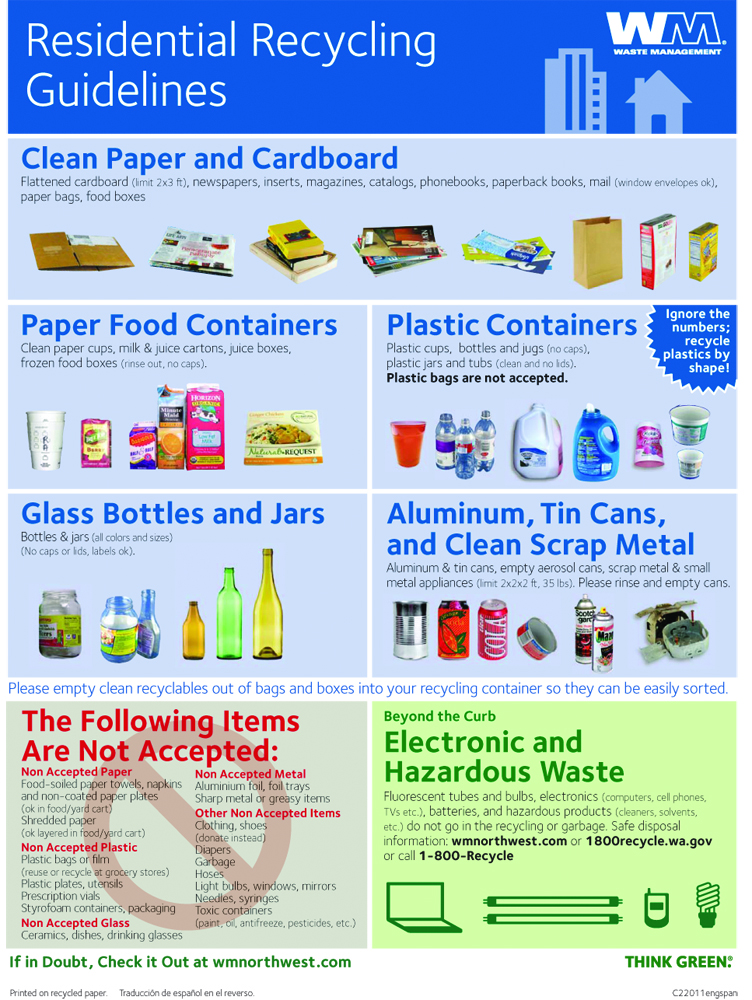By Micheal Rios, Tulalip News
Recycling is the process of collecting and processing materials that would otherwise be thrown away as trash and turning them into new products. Recycling benefits your community and the environment. As a sovereign tribal nation, the Tulalip Tribes’ core values includes conserving natural resources and sustaining our surrounding environment for future generations. That is why two years ago the Tulalip Tribes set out to implement a tribal wide recycling initiative.
The Solid Waste department was renamed the Solid Waste and Recycling department and was put in charge of the step-by-step process to bring a recycle, reduce, and reuse mantra to the reservation.
The first step took place on the tribal government level. The Tulalip and Quil Ceda Village (QCV) administration buildings received new recycling bins that separated cans, paper, and plastic into their own compartments. These bins were placed in specific common areas of each floor within the Tulalip Administration Building. In some cases, like the commonly populated first floor reception area and second floor lunch area, more specific type of recycling collection bins were used. These bins designated trash/organic, cans, plastic, and white paper only into their compartment.
What started out as voluntary program with the larger, more specific recycling bins on each floor had to evolve as it was observed employees were continuing to put their recyclables in their desk-side garbage bin. The bottom line was that it was more convenient to put recyclables in the desk-side garbage, rather than getting up and walking to the end of isle recycling bins.
“When we started our recycling program about two years ago it was a very small program. Mostly only our tribal government buildings were participating,” says Sam Davis, Solid Waste and Recycling Manager. “There wasn’t a lot of participation. People weren’t getting up and going to the end of the isles to dispose of their recycling, so last year I decided to make it easier and more convenient for everyone. We got these little desk-side recycling bins. We put the recycling bins at each and every desk. In all, we put over 700 desk-side recycling bins in tribal government buildings and Quil Ceda Village.”
Staff at Solid Waste and Recycling noticed a huge increase of recycling output once the smaller bins were put desk-side. It showed that Tulalip employees were consciously aware of what they could and couldn’t recycle, but the recycling program has to be convenient as well.
In 2014, with the larger end-of-isle bins and smaller desk-side bins in place, the Tribal Government collected and recycled 40.76 tons (81,520 pounds) of recyclable materials. Before the implementation of the tribal wide recycling initiative all of that 40.76 tons of recyclable materials would have gone the way of garbage and sent to landfills.
“It’s great to see the Tribal Government recycled 40.76 tons of paper, cardboard, plastic and aluminum,” says Davis. “In the next two years I’d like to double that amount. If you were to walk around and look in employee’s’ garbage you’ll still find recyclables in there. In 2014, the Tribal Government had an output of 726,820 pounds of garbage. I’d say that a 100,000 pounds of that is probably recyclable.”
The second step of the tribal wide recycling initiative took place on the residential level. The Solid Waste and Recycling department made life easier for community members by providing curbside recycling pickup services. They proveded a single-stream recycling bin that allows for community members to put all their recyclables into one bin without sorting. You have an easy way to reduce your impact on the environment and these materials are diverted from going into a landfill. The recycling collection crews come around on one of two days depending on your area and empty all curbside recycling bins. For Silver Village and Battle Creek residents, the pickup day is Thursday afternoon. For Y-site and Mission Highlands residents, the pickup day is Friday afternoon.
“Now, we have moved on to our tribal housing homes. We have put recycling bins at every single one of our housing homes except for the homes on the Quil, which is our next step,” continues Davis. “It’s been a step-by-step process because of the cost of each bin. It’s a onetime cost of $95 for each residential recycling bin, so it’ll take a while to recoup that cost, but in my eyes it’s worth it to not see all that recyclable material go to a landfill.
“It’s starting to get to where we want it to. Last month (February 2015) housing recycling did 4.41 tons, which is over 8,000 pounds. My goal is to get to 10,000 pounds a month for housing recycling.”
The residential housing recycling program started very slowly as recycling was a new concept for many in the Tulalip community, but, as the program continues to build momentum, more and more materials once considered garbage are now being recycled. In fact, Tulalip housing members are recycling nearly three times as much as they were only months ago. In October and November of 2014 there was an average of 1.81 tons of recycling collected, whereas in February 2015 there was 4.41 tons of recycling collected.
“I think it’s just people getting used to the program and us being consistent with our pickup. Knowing that we are actually doing something with it,” Davis says of the surge in residential recycling. “Follow through: I think that’s a big thing is knowing that if they put in that little bit of extra time to sort thru and fill their recyclable bin that we are going to be there to pick it up. We want to continue to educate our tribal members so that everything that can be recycled is being recycled.
“Recycling is not just a cost savings for us, it’s our way of looking out for our great-great-grandkids. The future generations.”
Contact Micheal Rios, mrios@tulaliptribes-nsn.gov

